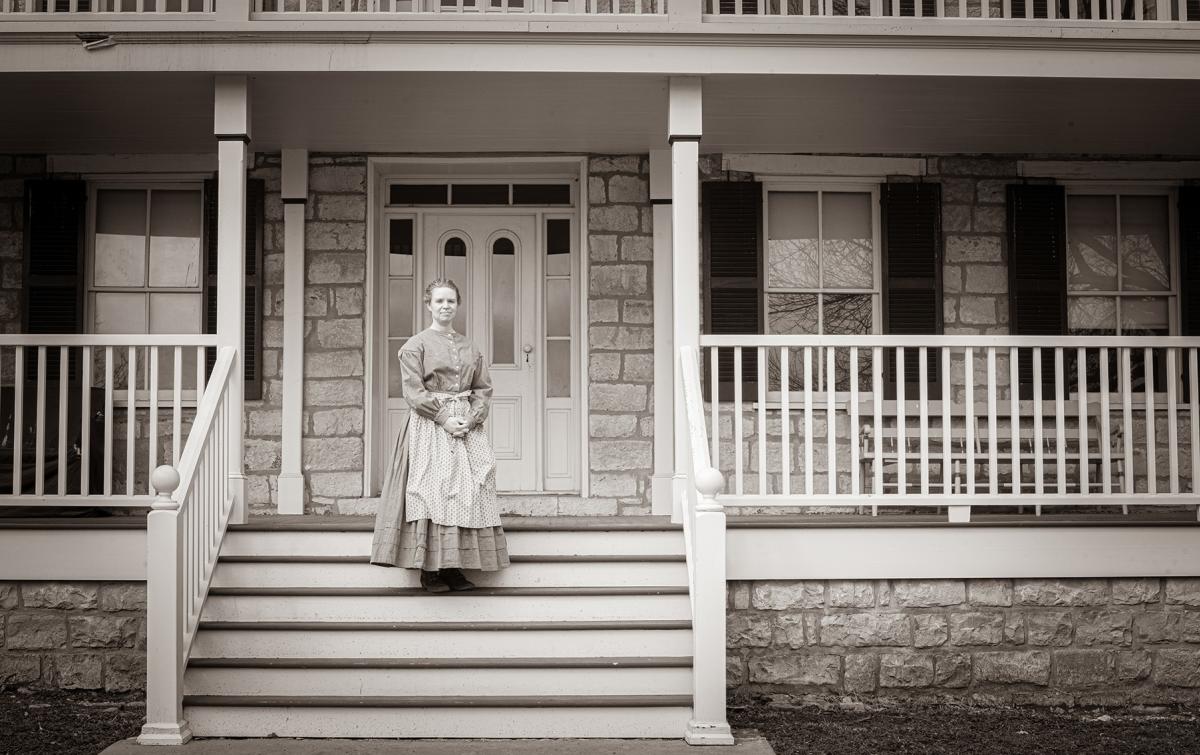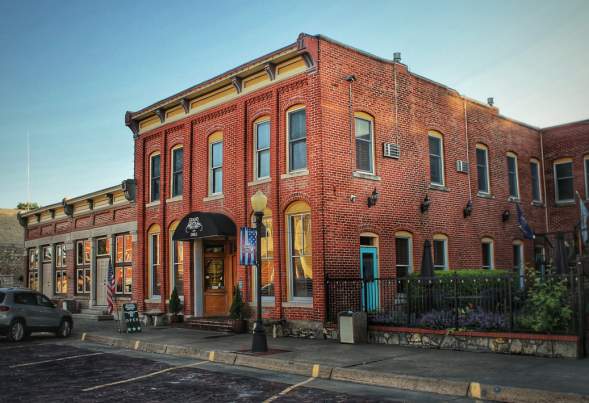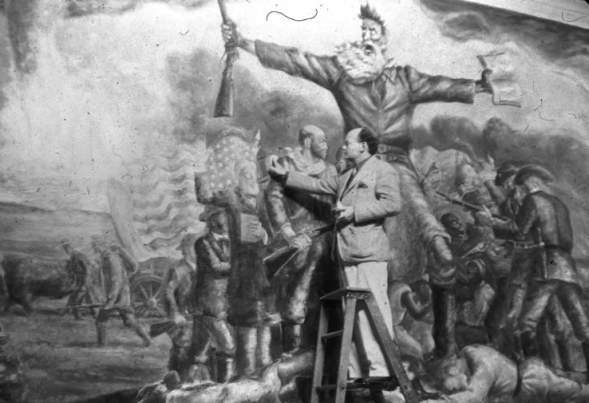ANDREA ETZEL (AE): Tell me about yourself, and how your journey lead you to Mahaffie?
ALEXIS RADIL (AR): I was born in Nebraska and have lived in Kansas most of my adult life, so I consider myself a Kansan. I have been lucky to have worked in some type of museum since 1994 when I started as a tour guide at Fort Robinson State Park in the northwest corner of Nebraska. I received my Master of Historical Administration and Museum Studies from the University of Kansas in 1999. My museum journey has taken me to Nebraska, Kansas, North Dakota and Colorado learning various operations of museums and historic sites. Mahaffie brought me back to Kansas in 2005, and thankfully, I’ve been here ever since.
AE: As Interpretive Specialist, please share a bit about your role.
AR: My main duties are to coordinate special events, such as 1860s Fireworks, Cemetery Tours, and Christmas Open House. Other aspects include manage the Mahaffie Market gift shop, conduct public relations tasks, managing content on the website, various administrative processes, attending meetings for professional organizations, and other duties as assigned. The unique aspects of working at Mahaffie may include feeding animals, conducting programs in 1860s clothes, and meeting with local officials all in one day!
AE: Was interpretive history always an interest for you?
AR: When I was attending the Museum Studies program at the University of Kansas, I had the opportunity to explore various aspects of museum functions. It is important to see how it all works together. During this program, I realized the importance of maintaining, caring for, and preserving objects, artifacts, and documents. There is a lot of administration tasks as well, financial, managing staff and volunteers, grant writing, strategic planning, and more that are a part of museums and historic sites. I am much more of a public-facing person where I feel most comfortable sharing history through engaging programs and activities. Interpretive history blends aspects of conversation, engaging the senses, and more to energize history.
AE: What do you like most about living history?
AR: Living history provides an opportunity to use all five senses to connect visitors to a historical and holistic experience. Visitors can touch reproduction artifacts, smell the cooking of a wood-burning cookstove or campfire, they can see what people would wear rather than seeing the clothing in a black and white picture. It provides different aspects of engaging all levels of interest. History can seem static and non-essential, the question I ask myself is ‘Who cares about what happened 150 years ago as there are so many issues today?’. Living history provides a way to connect each visitor personally to events that seem so out of touch. Living history gives opportunities to present history in an engaging manner rather than just citing facts and feeling static.
AE: Is interpreting living history different from reenacting? If so, please explain the differences in the experience?
AR: Interpreting is different than reenacting. I have not had a lot of experience being a reenactor, but I have worked with them. Activities following the guiding principles of interpretation to welcomes visitors to engage with the person, the place, the natural environment, and more. It also provides engagement and a two-way street for sharing history. Reenactors sometimes are focused on their individual persona and other reenactors rather than sharing their information with visitors. Reenactors have a part in helping historical places come alive, however, their main priority may not be engaging with visitors. Interpreters have professional training and principles to engage visitors on different levels. There are many resources for these interpretation techniques. Freeman Tilden, the author of Interpreting Our Heritage, is considered the standard.
AE: During my college years, I lived in Savannah, GA and worked as a docent for a house museum giving tours. My favorite part of the tour was sharing historical knowledge and seeing that “aha moment” when it connects to the person you’re talking to. What are some things you think people may not know or realize about Kansas life in mid 1800s?
AR: I have noticed that visitors may not realize the amount of technology people had access to in the mid- 1800s. Railroads brought manufactured goods, news, and all types of connections. I have noticed reactions of how colorful the 1860s clothes staff and volunteers wear at Mahaffie. Photography was usually black and white, and people are pleasantly surprised to see how they can identify with the 1860s clothes. I personally am surprised at the mobility of people in the mid-1800s. They had no issues with being on horseback for hours or even days at a time to get to the different places they wanted to go. Kansas also had some very progressive movements during the mid-1800s. After the Civil War, women and African Americans advocated for the right to vote and local elections in Kansas allowed women to vote. History provides opportunities to look back to explore and connect why the present is what it is. My hope is a visitor’s aha moment will lead to understanding the complexity of Kansas.
AE: If someone has an interest in becoming a historical interpreter, either has a career or volunteer, what’s your advice on how they should start?
AR: I would start with what interests you. You may have an interest in clothing, animals, furniture, a person, or other types of hobbies. Historical interpretation provides many avenues of using an individual’s passion to connect visitors. When visitors see your enthusiasm and knowledge of a topic, that carries to their interest. Be willing to be flexible, patient and ask questions. If you find a museum or historic site that you really connect with, have the confidence to reach out to them to see how your talents can enhance that organization.
AE: What is the best thing about what you do? And the worst?
AR: For me, the best thing about what I do is connecting people to the story of the Mahaffie family. You truly see how visitors of all ages can connect one aspect of their story to a family that lived over 150 years ago. If a visitor takes away a positive memory and comes back, I call that a win. Probably one of the worst things I encounter is apathy and the viewpoint that history is non-essential. It is easy to stay at home and not engage with the world around you. It can be especially challenging to bring an understanding of why the past is essential to understanding present situations and dream about the future. I truly enjoy the everchanging nature of what I do and it’s rewarding to have visitors share their fond memories and experiences.
Mahaffie Stagecoach Stop & Farm
AE: As some might know, Mahaffie was a stop during the Santa Fe Trail, but please tell our readers a bit more on its historical significance.
AR: Mahaffie Stagecoach Stop & Farm is the last remaining stagecoach stop open to the public on the Santa Fe Trail. When the limestone farmhouse was constructed, it was built with a full kitchen and dining room in the cellar. This was used by stagecoach passengers, and other travelers for meals. The Mahaffie family also sold surplus farm supplies to trail travelers. The limestone is still the original limestone from when James ‘Beatty’ Mahaffie and his oldest son, William built the house. The Mahaffie family encountered many Santa Fe Trail travelers going up and down the trail.
AE: What period(s) of time does Mahaffie reflect? What educational programs do you provide and how can guest participate and experience these historical times?
AR: Mahaffie focuses on 1860s-early 1880s. There are a variety of educational programs: structured school programs, homeschool programs, outreach programs for Active Agers, programs for day camps, scout programs, speakers on various topics for adult audiences, workshops, and more. Registration is required for these programs and our scheduler is happy to work with your organization. The most meaningful experience is to visit Mahaffie for an authentic sense of place. Many programs are led by staff and volunteers in 1860s clothes to share the content of what your organization needs.
AE: Can you share a bit about Mahaffie’s history, its transition from being a private home to now as a heritage educational site?
AR: James ‘Beatty’ Mahaffie, his wife Lucinda, and their five children moved to Johnson County in late 1857 from northwest Indiana. They settled in Olathe which was founded in the same year. They moved to the same place you can visit today in 1858 and began farming. The family grew more wheat than they needed in 1859 and considered to be the first successful commercial farm in Johnson County. As their farm grew, the Barlow, Sanderson & Company stagecoach line contracted with the Mahaffie’s to provide meals and livery service to stagecoaches. In 1869, James Mahaffie was on the first board of directors for the railroad when it arrived in Olathe. The Mahaffie farm thrived in the 1870s and in the early 1880s, James and Lucinda were able to retire from farming and move back to Olathe. Even though there were seven adult children (three more were born after moving to Olathe but one did not survive infanthood), none of them wanted to take over the farm. In the mid-1880s, James and Lucinda sold the property to a different family. Over the years, until the early 1970s, different families owned the property.
After the bicentennial in 1976, the owners were looking to sell and members of Olathe gathered momentum for the City to purchase the limestone house and property. The National Park Service was interested in purchasing the house but had limited funds. In 1979, the City of Olathe purchased the house. Through efforts of civic organizations, the Mahaffie house opened as a house museum in 1985. Shortly after, the Kansas Historical Society conducted an archeological dig to help gather artifacts. Through this effort, a reproduction smokehouse was constructed. In 1999, the first team of horses and a reproduction stagecoach were acquired. By 2010, Mahaffie was incorporating 1860s farming and other living history activities on a more consistent basis. Today, you can experience living history: 1860s Style!
AE: What are the own going preservation efforts of the site?
AR: Mahaffie is owned by the City of Olathe and administered by the Parks and Recreation department. The professionally trained staff works with various departments for maintenance of historic buildings, incorporating historically representative landscaping such as a garden and an orchard. The Site Manager, Tim Talbott, leads the preservation efforts through his expertise in American studies, material culture, and preservation. He works with various agencies and museum professional organizations for best practices and the Mahaffie staff uses their expertise to implement preservation.
AE: I’m sure to run a site such as Mahaffie requires a village, how many staff and volunteers do you have? (If you wouldn’t mind sharing so of types of positions – interpreters, visitor services, those who care for the animals.)
AR: Mahaffie has four full-time staff: Site Manager, Daily Programs Coordinator, Events Coordinator, and Livestock Manager. We have 15 part-time historic site guides and livestock staff that implement programs, activities, and care for the animals. Other full-time staff includes a Rental Manager and maintenance. We have approximately 50 volunteers, including 20 youth volunteers, who assist in various operations such as programs, collections care, and administrative tasks. The animal staff currently are five horses, three sheep, two goats and 15 chickens. The animals live at Mahaffie year-round and the Livestock Manager cares for them, drives the stagecoach, and even will shear the sheep!
AE: As we know this past year has had many negative impacts. How has Mahaffie faired? What ways have you had to pivot (for example: virtual learning)? What are the best ways people can show support today?
AR: History gives perspective and this past year has been quite a whirlwind. Mahaffie sits on approximately 20 outdoor acres. We were closed from mid-March 2020 through the end of May. We reopened June 1 and discovered the public was comfortable being in an outdoor setting. Our staff and volunteers have adapted by following recommended public health guidelines and we have adapted our hands-on activities while still engaging the public. The Mahaffie’s endured quite a bit during their days, such as the Border/Civil War, disease, death, and all types of challenges. They adapted to their situation to develop a successful farm, so we used their story as inspiration for today. The Mahaffie’s used the best technology of the 1870s and we adapted. We developed virtual programs, used available tools such as video, virtual programs, and reaching out to organizations that we are willing to go to them to keep our name out there. One of the most successful activities were the Letters to the Animals campaign. Stagecoaches primarily carried the mail and when letters were received by the animals, our staff replied using our animal knowledge. We received over 200 letters from eight different states and a journalist from India contacted Mahaffie through our Facebook page to learn more. When the animals wrote back, we included guest passes to encourage them to visit!
There are different ways to show support. You can follow our Facebook page and Instagram. Make time to visit and after your visit, share your experience with others. Our farming activities change and there is something new to discover. Purchase a membership and shop in the Mahaffie Market Gift Shop. Another way is to think of hosting your special event at Mahaffie such as a wedding, reception, or other events. All revenue generated through these efforts supports our operations. Think about being a volunteer or serve on the Mahaffie Foundation board.
Switching Gears
AE: Where’s your favorite place in Kansas? What is still on your bucket list to do?
AR: Besides Mahaffie, the Kansas Capitol. I had the honor of coordinating and giving tours for the Kansas Historical Society before the lovely restoration. There is nowhere else to learn about a state’s unique history in one hour than a tour of the state capitol. My other favorite place is Tallgrass Prairie preserve. The vastness of the Flint Hills and the prairie landscape mesmerizes me.
I want to visit Mt. Sunflower and Little Jerusalem State Park. There is a perception that Kansas is flat and sterile. The pictures I have seen from each area are intriguing and fascinating. There is more to our wonderful state than traveling through on I-70.
AE: Since 2021 marks the 200th year of the Santa Fe Trail, along with Mahaffie what other sites would you recommend our readers to visit?
AR: Battle of Blackjack near Baldwin City, KS. There are swales from the Santa Fe Trail, and it is a lovely nature park. You get a sense of the vastness of the trail by seeing how wide the swales are. Council Grove, KS, has many places about the trail. You can learn more about the indigenous people’s experience through the Kaw Mission. Fort Larned, KS, and Bent’s Fort are National Park Service sites that share the multiple stories of the trail. The Santa Fe Trail Association has really done an excellent job coordinating signs along the modern highways for travelers to also experience the hidden gems of the trail.
Ways to Stay Connected
More Articles You'll Enjoy
Black History Trail of Geary County
Mar 08, 2024Jim Sands, President of the Black History Trail of Geary County / Photography by Nick Krug A county… Read More
Quindaro: A Great, Nearly Lost City of Free Peoples
Mar 07, 2024Photography by Andrea LaRayne Etzel & Carter Gaskins Quindaro was an abolitionist frontier city… Read More
Historic Hotels in Kansas
Feb 02, 2024Grand old lodgings in Kansas offer peek into the past Historic hotels offer more than a good… Read More
From the Archives: Remembering John Steuart Curry
Jan 15, 2024Editor's Note: This article was originally published in the winter of 1992 by Don Lambert… Read More
From the Archives: Birth of the Helicopter
Jan 08, 2024Editor’s Note This article was originally featured in the winter issue of 1983 by Joan L… Read More










